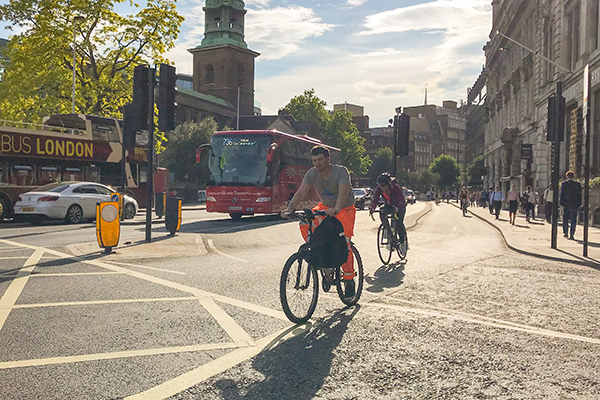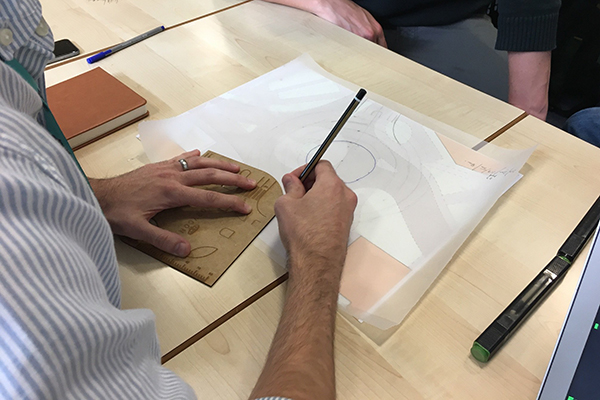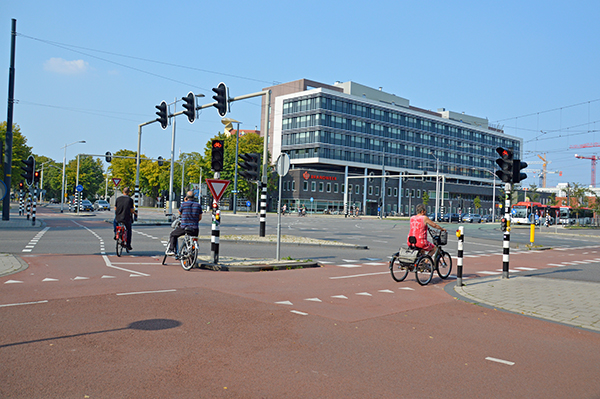Bicycle Policy / Bike Strategy / Conference / Cycle culture / Cycling / Cycling Education / Cycling infrastructure / Education / Infrastructure / Workshop
De-Stressing Intersections by Design
Many cities have recognized that the old approach to street design is not serving the most vulnerable of our citizens. There’s a general consensus that on busy thoroughfares with high levels of motorized traffic, building safe, human-centred and protected infrastructure is best. Nowadays most planners and engineers know what a well-designed cycle track looks like. However, as Senior Urban Mobility Advisor Lennart Nout explains, there is still a knowledge gap when it comes to addressing when those streets intersect.

“When it comes to intersections, there is still a lot of conflicting interests and misunderstanding about what is important at intersections,” says Lennart. “There are a number of myths about what is better to do at the intersection that we need to clarify if we’re really going to make our roads safer.” This is the motivating factor behind Mobycon’s Masterclass Building for Bikes: The Dutch Approach to Junction Design. To help bridge that gap and encourage cities to re-examine their current approach to designing intersections and identify what steps can be taken to make them safer not just for cyclists, but for everyone.
Protected intersections are key top de-stressing the network
Throughout the autumn, Mobycon will be running four separate masterclass sessions in partnership with Landor Links. For Lennart, the appetite for learning about intersection design in the UK is a reflection of the investments being made in cycling across the country. “There is a lot of focus on building new cycle ways and getting more people on bikes,” he explains. “Now they need to get to the point where it is safe to cycle for everyone.” This means de-stressing the network to the point where it is relaxing to cycle, no matter your age or ability. “Having safe, easy to understand and low stress intersections is a vital link in that network.”
In cities like London, extensive “cycle superhighways” – networks of protected cycle ways – have been expanding to provide connections throughout the City’s many boroughs. While these facilities have made cycling much safer, there still exists concerns with mixing modes at intersections. Taking a different approach to these high-conflict areas will not only make conditions safer, they also become easier for everyone – pedestrian, cyclists and motorist – to understand.

Bringing a context-based approach
So, what does Mobycon bring to the conversation and why have these masterclasses been so well received? For one, our mobility advisors have been working with communities of all sizes for decades to build safe, comfortable spaces for decades. Through this experience, we have become well-versed in translating Dutch knowledge of street design to an English – or elsewhere – context. “We work globally and understand that everyone is different with different laws, regulations and cycle behaviour,” says Lennart, “But at the end of the day we’re all human and by building human-centred intersections you can make the whole mobility system happy.”
Focusing on the underlying principles
What makes our approach so integral in de-stressing intersections is that when we run this masterclass we always focus on the underlying principles. Closing the knowledge gap is more than just providing a blueprint of what good design should look like. The masterclasses focus on actually giving participants the tools they need to design their own versions, giving them the fundamentals they need to then be able to think about compromises they’re making.
“You can never fit the perfect intersection everywhere – and that’s fine. No Dutch intersections are perfectly alike,” Lennart admits, “but you need to understand which things you’re trading off against each other if you really want to make an informed decision on what it will eventually look like. By teaching the fundamentals from a Dutch perspective you can apply the same fundamentals to a UK perspective.”

The misperception of ‘Space’
Lennart is one of a number of our advisors who have run this and similar masterclasses in the UK, across North America, in various European countries, as well as through online webinars. While the geographical context changes place to place, many of the common challenges to implementing protected intersections tend to surface. More often than not, there is the question of space. It is often difficult for designers and engineers to look at an existing space and imagine where they could possibly find the space to maintain traffic flow while also building in safety for cycles and pedestrians. Lennart challenges that thinking though: “If you set the right priorities even when you think you don’t have enough, you will quickly see there is always enough space.” If the goal is to make the area safer for people on foot or cycles, then the priority needs to be given to them. After that commitment is made, often the redesign becomes much easier.
An approach that works for everyone
Because protected intersections are still relatively new, there are often questions on how to cater for individuals with disabilities in an environment that is different than what they may be accustomed to. Lennart notes that many questions focus on the particular challenges for the visually impaired who rely on sound and sensory cues to let them know when conditions are safe to cross. But he argues this is more of a perceived challenge than an impossible one.
“There are a few interventions that can be done to make it just as safe for visually impaired,” he states. “It just means you have to bring them along on the process of designing so they know what’s coming.” Engaging the right parties at the appropriate stages in the project, and listening to and addressing their concerns while explaining what it is you’re trying to do is key to building an understanding. “In the end, the design may be different from what they are used to, but it is inherently safer, so it benefits everyone equally.”

“We’ve heard all the arguments. We can help.”
Almost every progressive city is experimenting with re-examining their approach to intersection design as an extension of their growing cycle networks. There are a lot of great examples coming out of places like Vancouver, Canada, Davis, California, as well as a number of cities in the UK. As they explore the possibilities, Mobycon’s masterclasses provide an opportunity to learn from best practice and how to apply it to the context of your own city. “We’ve heard all of the arguments against doing one of these, so we know why people think it’s impossible,” Lennart emphasizes. “We can help. In working in a lot of different environments we have the experience to help you work through your local challenges and build something that creates a safe, stress-free environment for everyone.”
If you would like to learn more about our approach to intersection design, we will be running masterclasses at the International Healthy Streets Summit in Glasgow the 9-10 of October and Walking and Cycling Innovations in Manchester the 3rd of December. Can’t make these sessions? Contact us about setting up a session in your area.

